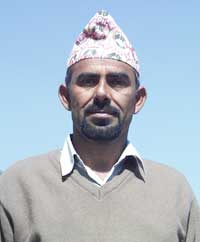 When Hari Bairagi Dahal was the UML MP from Sankhuwasabha district five years ago, the one thing people in his constituency always asked for was electricity. He tried, he went around the government ministries in Kathmandu, he even staged a sit-in outside Singha Darbar to increase the allocation for infrastructure development for his district. But no one listened. He could not deliver, and he also lost his party ticket to contest the 1998 elections.
When Hari Bairagi Dahal was the UML MP from Sankhuwasabha district five years ago, the one thing people in his constituency always asked for was electricity. He tried, he went around the government ministries in Kathmandu, he even staged a sit-in outside Singha Darbar to increase the allocation for infrastructure development for his district. But no one listened. He could not deliver, and he also lost his party ticket to contest the 1998 elections. Any other ex-politician would have returned to his hometown to lick his wounds and butter the party bosses for a political comeback. Not Dahal. If his people wanted electricity, electricity they would get. So what, if he wasn't a politician anymore?
Dahal got together a group of local businessmen, took a loan from a consortium of banks in Kathmandu and invested in the Piluwa Khola hydropower plant near Chainpur that will star providing 3 mW of power to the national grid by April.
Taking advantage of a landmark policy approved by then deputy prime minister Shailaja Acharya in 1995 which set out a formula for the Nepal Electricity Authority's buy-back rate from private power suppliers, and stipulated an annual six percent increase for a certain period for power from small hydro projects, Dahal had no problem convincing bankers that it was a sound return on investment. The buy-back rate was set at Rs 4 per kW-hour for peak power and Rs 2.75 non-peak.
"Why go grovelling to bureaucrats in Kathmandu, I told myself. We have the water, we have the resources, we will make it ourselves," Dahal told us. So, the Arun Valley Hydro Power Development Company Pvt Ltd was set up. Says Dahal: "What I realised is that if you have a good proposal, and it makes sound business sense, the bankers will bite."
And they did. Dahal's partners put in 30 percent of the Rs 280 million for Piluwa, and the banks put in 70 percent and the project got underway two years ago. In fact, private hydropower development in Nepal has become so lucrative Dahal is surprised more businesses in Kathmandu aren't jumping onto the bandwagon. "In very few ventures do you have both the raw material and the market guaranteed," he says. "With hydropower the raw material is water, and the market is the NEA."
ge one megawatt small-scale hydropower project in Nepal costs about Rs 100 million, and banks are willing to lend up to 70 percent of the amount. Private investors need to put in the rest, and a partnership of five individuals makes such a project surprisingly affordable. Says Dahal: "You don't have to be super-rich to invest in hydropower in Nepal anymore. And the beauty of it is that you get your money back within five years."
The reason small hydropower is so cheap is that the projects can be indigenously designed and built, they need no expensive foreign consultants, no foreign loans, and it can all be financed with Nepali rupee credit, thus eliminating the danger of dollar appreciation.
Dahal has no illusions about why he succeeded. "I wouldn't have been able to deal with the red-tape if I hadn't been in politics. I knew Singha Darbar inside out, and that helped," he explains. Dahal says he hasn't left politics, and will try to get elected again from his home district after the project is finished.
The lesson from Hari Bairagi Dahal's project is that small is feasible. Twenty five-megawatt projects would be cheaper, more appropriate, less of a burden on the national exchequer, and could be built and financed within Nepal-compared to one 100 mW project. Just look at the figures-Piluwa Khola costs $1,200 per kW to build in local money, while the Arun project would have cost nearly $5,000 in hard currency. The 144 mW Kali Gandaki project costs $3,300 per kilowatt.


